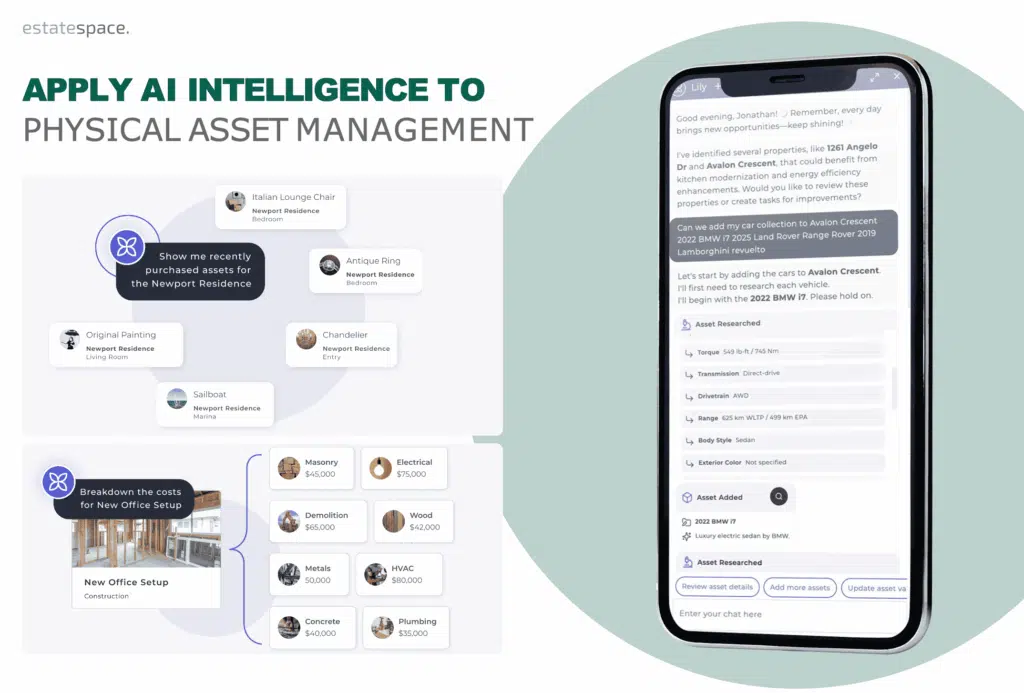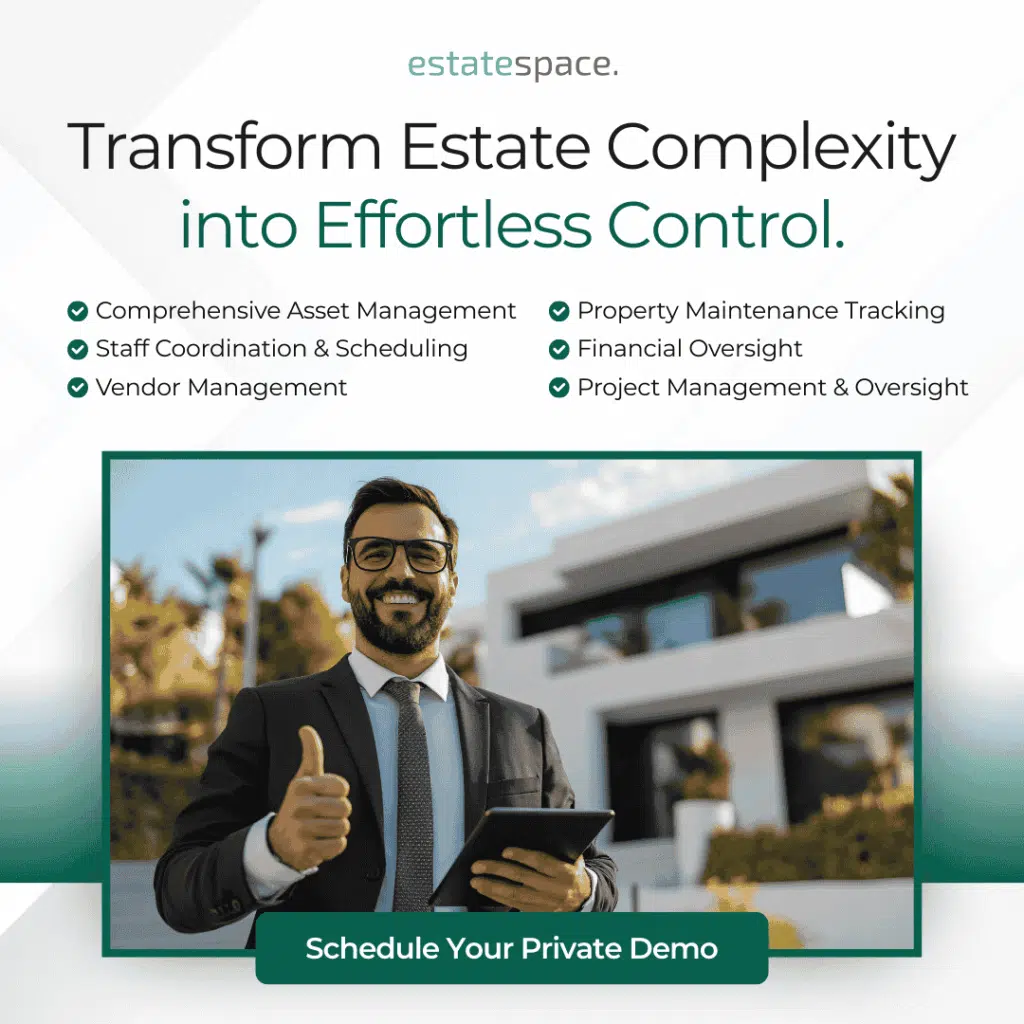Luxury estate management software transforms how high-net-worth families and their teams operate complex property portfolios. However, without purpose-built luxury estate management software, most teams spend 60% of their time hunting for basic information—paint colors, vendor contacts, maintenance histories—scattered across spreadsheets, binders, and departed employees’ memories.
Unfortunately, this administrative burden doesn’t just waste time. In fact, it erodes asset value through reactive maintenance, prevents sophisticated reporting that justifies premium fees, and creates succession nightmares when institutional knowledge walks out the door during team transitions.
Why Generic Estate Management Software Fails Luxury Operations
Standard platforms weren’t designed for high-value estate portfolios. As a result, they lack the security, lifecycle coverage, and intelligence required for managing complex asset ecosystems where a delayed wine delivery isn’t a vendor issue—it’s a relationship crisis.
The Hidden Costs of Inadequate Software Solutions
| Operational Challenge | Annual Cost Impact | Time Burden |
|---|---|---|
| Knowledge loss during transitions | $25,000–$100,000 per event | 6–12 months onboarding |
| Hidden carrying cost overruns | 15–20% budget excess | 3+ hours daily searching |
| Reactive crisis management | Variable emergency costs | 60% admin vs. strategic work |
| Missed renewal deadlines | Insurance gaps, penalties | Constant manual tracking |
The real operational costs include:
- Knowledge loss during transitions – When estate managers leave, 6-12 months of institutional knowledge disappears without systems to capture operational insights
- Hidden carrying cost overruns – Furthermore, estates typically spend 15-20% more than necessary on maintenance without consolidated expense tracking
- Administrative time theft – Additionally, estate professionals spend three hours daily searching for information that should be instantly accessible
- Reactive crisis management – Moreover, missed insurance renewals and overlooked maintenance create expensive emergencies
According to Forbes’ analysis of luxury estate management, technology adoption in high-net-worth estate operations directly correlates with operational cost reduction and client satisfaction improvements.
How AI-Powered Estate Management Software Eliminates Work
In contrast, modern platforms like EstateSpace don’t just organize tasks—they eliminate them entirely through intelligent automation. Specifically, the best luxury estate management software uses AI to handle administrative work that traditionally consumed 60% of staff time.
5 Ways AI-Driven Estate Software Transforms Operations
- Automated asset mapping – First, drop spreadsheets into the platform and AI maps every asset, vendor relationship, and maintenance schedule automatically
- Photo-to-asset conversion – Next, upload estate photos and AI creates detailed records with specifications extracted from image metadata
- Intelligent schedule generation – Then, add new estates and AI generates preventative maintenance schedules based on asset types, assigning tasks to appropriate team members
- Pattern recognition – Additionally, AI identifies maintenance cost patterns across portfolios and flags optimal vendor performance metrics
- Predictive recommendations – Finally, the platform surfaces hidden efficiency opportunities that human analysis typically misses
Importantly, this isn’t task management—it’s asset intelligence that solves complex management challenges through predictive analysis.
The Operational Transformation from Modern Platforms
Predictive maintenance timing: Rather than reactive repairs, predictive asset maintenance analyzes historical patterns to schedule service before failures occur. For example, HVAC systems, pool equipment, and mechanical systems receive attention at optimal intervals—preventing emergencies while reducing total maintenance costs.
Proactive risk mitigation: Similarly, automated monitoring catches expiring insurance policies, upcoming regulatory compliance deadlines, and maintenance gaps before they create liability exposure. As a result, physical asset risk management becomes proactive rather than reactive.
Institutional knowledge preservation: Furthermore, every maintenance event, vendor interaction, and operational decision gets captured with full context. Therefore, when team members transition, their expertise remains accessible—eliminating the costly knowledge loss that typically follows personnel changes.
Complete Lifecycle Coverage in Estate Management Systems
Unlike point solutions that handle single operational phases, comprehensive luxury estate management software covers the entire asset lifecycle. Specifically, this includes everything from construction through decades of operations to eventual ownership transfer.
| Lifecycle Phase | Traditional Approach | EstateSpace AI Platform |
|---|---|---|
| Construction/Acquisition | Separate project management tools, manual data transfer | Project budgeting with CSI codes, RFI tracking, submittal management in one platform |
| Ongoing Operations | Spreadsheets, multiple task managers, fragmented communication | Consolidated maintenance scheduling, vendor tracking, automated workflows |
| Ownership Transfer | Knowledge loss, manual documentation, 6–12 month transitions | Complete asset inventories with full histories transfer in one click |
Construction and acquisition phase: Initially, project budgeting with CSI codes, RFI tracking, submittal management, and contractor coordination happen in one platform. Subsequently, as construction completes, the system transitions seamlessly to operations—maintaining all vendor relationships, specifications, and project history without manual data migration.
Ongoing operations management: Meanwhile, estate asset tracking platforms consolidate preventative maintenance scheduling, vendor performance monitoring, expense tracking, and team task workflows. Consequently, real-time visibility across all estates eliminates the information chaos that forces managers into constant reactive mode.
Ownership transfer capabilities: Eventually, when estates change hands—whether through sale, generational transfer, or management company transition—complete asset inventories with full maintenance histories transfer in one click. Therefore, the institutional knowledge that typically evaporates during transitions becomes permanent portfolio intelligence.
Overall, this lifecycle approach addresses the fundamental challenge family offices face: maintaining operational excellence across decades while team members inevitably transition. In particular, family office asset management systems must support not just current operations but generational continuity.
Enterprise Security in Luxury Estate Software Platforms
Luxury estate portfolios contain sensitive wealth information requiring bank-level security that generic tools don’t provide. Therefore, when evaluating luxury estate management software, security certifications should be non-negotiable.
Industry-Leading Security Standards for Estate Operations
- SOC 2 Type 2 – Operational security controls audited and verified
- HIPAA Compliance – Health-related facility information protected
- GDPR Compliance – International data privacy standards met
- PCI DSS – Payment card data protection ensured
Role-based permissions enable granular privacy control. For instance, principals see financial summaries while estate staff access operational details and vendors view only their assigned estates. Additionally, multi-tenant architecture ensures complete data isolation between client portfolios.
For asset managers serving multiple family office clients, these security capabilities enable sophisticated permission scenarios where each client’s sensitive information remains completely segregated. Ultimately, this is critical for maintaining discretionary relationships with high-net-worth individuals.
How Estate Management Software Consolidates Technology Stacks
Rather than adding another tool to manage, effective luxury estate management software replaces 7-10 existing technologies. As a result, it creates the single source of truth that high-performing estate teams require.
What Comprehensive Estate Software Consolidates
- Spreadsheets – Asset tracking, vendor lists, maintenance schedules, budget forecasting
- Document storage – Dropbox, SharePoint, binders, email attachments consolidated into searchable archives
- Task managers – Asana, Monday, Trello replaced with context-aware assignment workflows
- Project management – Procore-level budgeting adapted for residential estate operations
- Communication tools – In-app messaging replaces fragmented email chains and text threads
- Reporting systems – Automated, configurable reports eliminate manual compilation
- Calendar systems – Integrates with Google, Outlook, iCal for unified scheduling
Consequently, breaking data silos across asset management operations creates the single source of truth that enables strategic decision-making. Indeed, when every estate detail, vendor relationship, maintenance history, and expense record lives in one AI-powered system, you stop managing technology and start optimizing operations.
Moreover, asset management automation specifically benefits estate professionals who previously spent 60% of their time on administrative work. Instead, that time becomes strategic relationship building, proactive service design, and sophisticated reporting that justifies premium pricing.
Strategic Reporting Capabilities in Estate Management Tools
High-net-worth clients increasingly expect sophisticated visibility into their estate operations. However, basic status updates no longer suffice when hidden costs are destroying asset value through untracked maintenance overruns and vendor inefficiencies.
Reports That Transform Client Relationships
- Completed maintenance portfolios – Comprehensive activity logs across all estates with photo documentation
- Vendor performance analytics – Cost comparisons, response times, quality metrics across service providers
- Preventative action summaries – Evidence of avoided emergencies through proactive maintenance timing
- Operational efficiency trends – Year-over-year improvements in costs, response times, asset longevity
Ultimately, these reports transform client conversations from reactive explanations to proactive demonstrations of strategic value. Instead of answering “what have you been doing,” you’re presenting quantified evidence of cost savings, risk mitigation, and enhanced operational efficiency.
For project managers seeking to evolve from one-time construction relationships into ongoing estate management partnerships, sophisticated reporting capabilities create competitive differentiation that justifies premium positioning.
Moving Beyond Traditional Approaches
Traditional asset oversight methods rely on manual processes that can’t scale across complex portfolios. In contrast, modern platforms transform oversight from reactive monitoring to proactive intelligence—identifying optimization opportunities before they become visible problems.
Furthermore, the shift from spreadsheet-based tracking to AI-powered automation represents more than efficiency gains. In fact, it fundamentally changes how estate professionals deliver value, moving from administrative coordination to strategic advisory relationships with clients who trust them with their most valuable assets.
Implementation Built on Real Experience
EstateSpace was built by operators who spent 16 years managing complex luxury estates before creating the platform they wished existed. Specifically, every feature addresses real operational pain points experienced firsthand—the spreadsheet chaos, knowledge loss during transitions, inability to demonstrate value to sophisticated clients.
Moreover, the product roadmap comes from operational experience, not software development theory. This origin matters because luxury estate management requires understanding that delayed service isn’t just a scheduling issue—it’s a relationship crisis that erodes client trust built over years.
Next Steps: Selecting Estate Management Software
Your Implementation Roadmap
- Map your technology stack – First, document every tool your team uses daily for estate operations
- Calculate time allocation – Next, track weekly hours spent on administrative versus strategic work
- Identify pain points – Then, list issues that directly impact client satisfaction or team efficiency
- Evaluate consolidation opportunities – Additionally, determine which fragmented systems could be unified
- Schedule a platform assessment – Finally, see how AI-powered automation applies to your specific portfolio
Importantly, modern technology doesn’t replace the personal touch that defines exceptional service—it amplifies your team’s ability to deliver it consistently across multiple estates.
Contact EstateSpace for a personalized assessment of your current systems and see how AI-powered estate operations eliminate administrative burden while building institutional knowledge that survives transitions.






